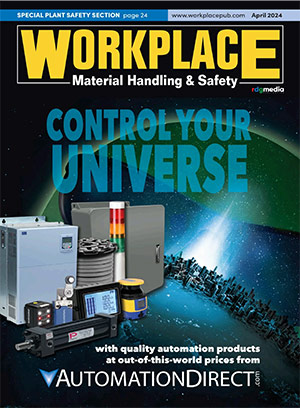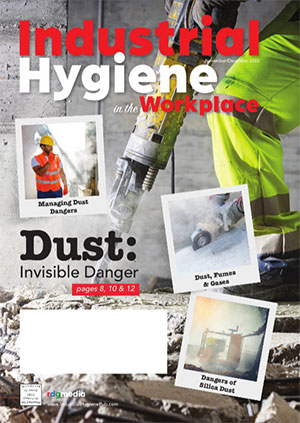Saving Space with Overhead Equipment
Debra Schug, Contributing Writer
 To keep up with demand, the workplace floor space is getting ever tighter with added equipment and/or bodies. What to do when there isn’t an inch more to spare? Go up, of course.
To keep up with demand, the workplace floor space is getting ever tighter with added equipment and/or bodies. What to do when there isn’t an inch more to spare? Go up, of course.
While overhead lifting and moving equipment isn’t new, there are some technological innovations in this area offering more benefits. And, for operations that either physically can’t expand or don’t have the funds necessary to build out a bigger footprint, overhead equipment can do wonders in terms of maximizing efficiency and flexibility.
On-floor Versus Overhead Systems
Generally, two options are available for moving product from point A to point B: on-floor movers and overhead movers. On-floor moving equipment can include hand trucks, forklifts and conveyor systems, while overhead movers include cranes, hoists and monorails.
There are some benefits to trucks and forklifts, such as being cheaper to initially purchase as well as maintain. Conveyors can be rather costly and difficult to install, but they are effective for continuous and high-volume material movement.
But on-floor moving equipment requires floor space, as the category’s name denotes. Plus, there are some possible safety risks: Trucks can run into people, structures or equipment; forklifts can overturn if improperly used; and conveyors operate at worker level, which can result in people or items getting caught in the machinery.
On the other hand, overhead material handling solutions can improve worker safety, since they do the lifting for the employee, thus, reducing accidents and injuries by improper lifting. According to recent U.S. Bureau of Labor Statistics on days away from work (DAFW) injuries, 118,050 manufacturing workers had sustained an occupational injury, resulting in an average of nine days away from work. Sprains, strains or tears accounted for 30% of the DAFW cases in manufacturing, many of which are due to improper lifting.
Probably the biggest benefit of overhead equipment is the minimal, if any, floor space it requires. In particular, overhead cranes are ideal for facilities with narrow, crowded aisles. While freestanding or stand-alone cranes and hoists require support structures from the floor, the footprint those occupy is much smaller in comparison to on-floor movers. Plus, these structures can be placed along the edges of a facility.
Moreover, overhead bridge cranes and monorails require no floor space at all due to their support structures being mounted onto the building’s roof. Regardless of the type of support structure, because of the robust nature of their support, overhead systems also have a large load capacity, which is limited with some on-floor moving applications, such as hand trucks.
Different Types of Overhead Equipment
 There are three different categories of overhead equipment: cranes, hoists and monorails. All offer different benefits for different operational needs.
There are three different categories of overhead equipment: cranes, hoists and monorails. All offer different benefits for different operational needs.
For instance, overhead cranes use hooks, hoists, magnets and other devices to move materials. They are easy and economical to use, adapting to most facilities’ layouts and operating on any plant floor surface. Specifically, jib cranes can operate around a central space and rotate a full 360 degrees. Bridge cranes and gantry cranes move on three axles, one vertical and two perpendicular, which makes them ideal to work in narrow spaces.
“A bridge crane can be a simple modular component made to handle less than a hundred pounds or can be designed to handle hundreds of tons,” said Brian Stephens, Senior Product Manager of modular cranes and drives for Demag Cranes and Components Corp. “They can be anywhere from a push/pull system to a highly automated system, it all depends upon what the customer needs for their application.”
Hoists, on the other hand, can easily be fitted for longer-lifting capabilities and are easy to transport to different locations. They can be used inside operations or outdoors, which is why both construction and warehousing environments use them. They are simple devices, but can be used in a number of different applications, as they are designed to lift and move suspended, unguided loads. Hoists can consist of wire, rope or chains and can be operated manually, electrically or pneumatically.
Monorails operate on tracks, either on a single route or interconnecting a network of several tracks, and are installed directly onto a facility’s roof. They can have one or more carriers on each track. Unlike conveyors, they occupy no floor space; however, like conveyors, they operate on a restricted path where the track has been installed, so the range of lifting movement can be limited.
“These would be used in applications where you will always be picking up and placing products at fixed points and do not need the ability to work outside of those areas,” said Stephens.
Operation and Controls
 One of the biggest misconceptions of overhead lifting systems is that they are complicated. In reality, the controls on overhead lifting solutions are straightforward and actually have fewer electrical and mechanical components compared to other moving equipment, such as conveyors.
One of the biggest misconceptions of overhead lifting systems is that they are complicated. In reality, the controls on overhead lifting solutions are straightforward and actually have fewer electrical and mechanical components compared to other moving equipment, such as conveyors.
For example, on electrified overhead crane systems, a single operator can direct the movement of the crane and the hoist in three ways: crane motion, or moving the crane up and down; hoist positioning, or the lateral movement; and hoisting lifting motion, referring to the moving of the hook up and down.
In basic crane operations, a worker controls the crane from an attached cab and another worker uses hand signals to instruct the operator on directional movements. However, more modern systems today allow one operator to use a push-button pendant system, which is attached to the crane.
Also, wireless controls can allow cranes to be remotely operated, offering an extra safety element of keeping workers well away from materials being lifted. However, when these devices first appeared on the scene a few decades ago, they got a pretty bad reputation. Early models used a remote transmitter to send a radio signal to a receiver on the crane, which then transformed the signal to electrical energy. Many of these devices had interference issues leading to productivity problems and frustration all around.
Advances in technology have improved the transmitter and receiver process, leading to greater reliability. Plus, as these controls have become more common, their once cost-prohibitive prices have been significantly reduced.
The Latest Technology
 Many of today’s overhead solutions incorporate technological improvements to enhance operations. As the manufacturing industry as a whole becomes more data driven, so does overhead lifting equipment, with advanced controls providing maintenance diagnostics and data on metrics such as runtime hours, average load-weight and number of transfers.
Many of today’s overhead solutions incorporate technological improvements to enhance operations. As the manufacturing industry as a whole becomes more data driven, so does overhead lifting equipment, with advanced controls providing maintenance diagnostics and data on metrics such as runtime hours, average load-weight and number of transfers.
“The latest innovations in the overhead equipment field are electronics and communication,” said Stephens. “More and more data is being captured, analyzed and communicated by the devices themselves to insure safe and reliable operation.”
Having insight into how the equipment is being used and when it might need a tune up can greatly boost productivity by reducing unplanned downtime.
“Being able to inform the customer that their equipment needs maintenance before failure is big advantage in a manufacturing/assembly environment,” said Stephens. “This can help a facility by letting the maintenance staff know exactly when to service the product or alert them to a potential problem in the near future.”
Additionally, material advancements in rope and chain have extended the life of these systems, which increases the years of safe operation these solutions offer. Also, advances in electric controls have helped smooth the starting and stopping of lifting and moving motions, which helps improve precision in load-positioning and reduces the risk of damaging product.
Overhead lifting systems can be powered by compressed air, known as air balancers, or motors, known as servo. Air balancers achieve more natural-lifting motions and are limited to capacities of approximately 1,000lbs.
Servo hoists are controlled by industrial processors and provide more lifting power than air balancers, with a capacity of 1,350lbs up to 2,000lbs. Because of their precision and fast action, both servo and air balancers are better options for applications involving careful-handling.
One of the biggest growing areas in this field is the introduction of intelligent lifting devices, which are computer-controlled and enable a worker to lift and manipulate product as if it were an arm extension. These devices are filling in the gap between manual-lifting devices and completely automated robotic solutions.
While the work is done by the intelligent system, the operator still has control over the device. Movements by the lifting system mimic human motion, but with enhanced speed and precision. Intelligent lifting devices use high-speed servo control systems and integrate with an enterprise’s process and control systems.
With smarter operations of overhead equipment, the benefits of additional floor space and worker safety, along with increased efficiency are all improved. However, all of these bells and whistles aside, even the most cutting-edge overhead lifting system still uses the simple and logical methods of a hoist. And, this has been a proven method of material handling for years.



